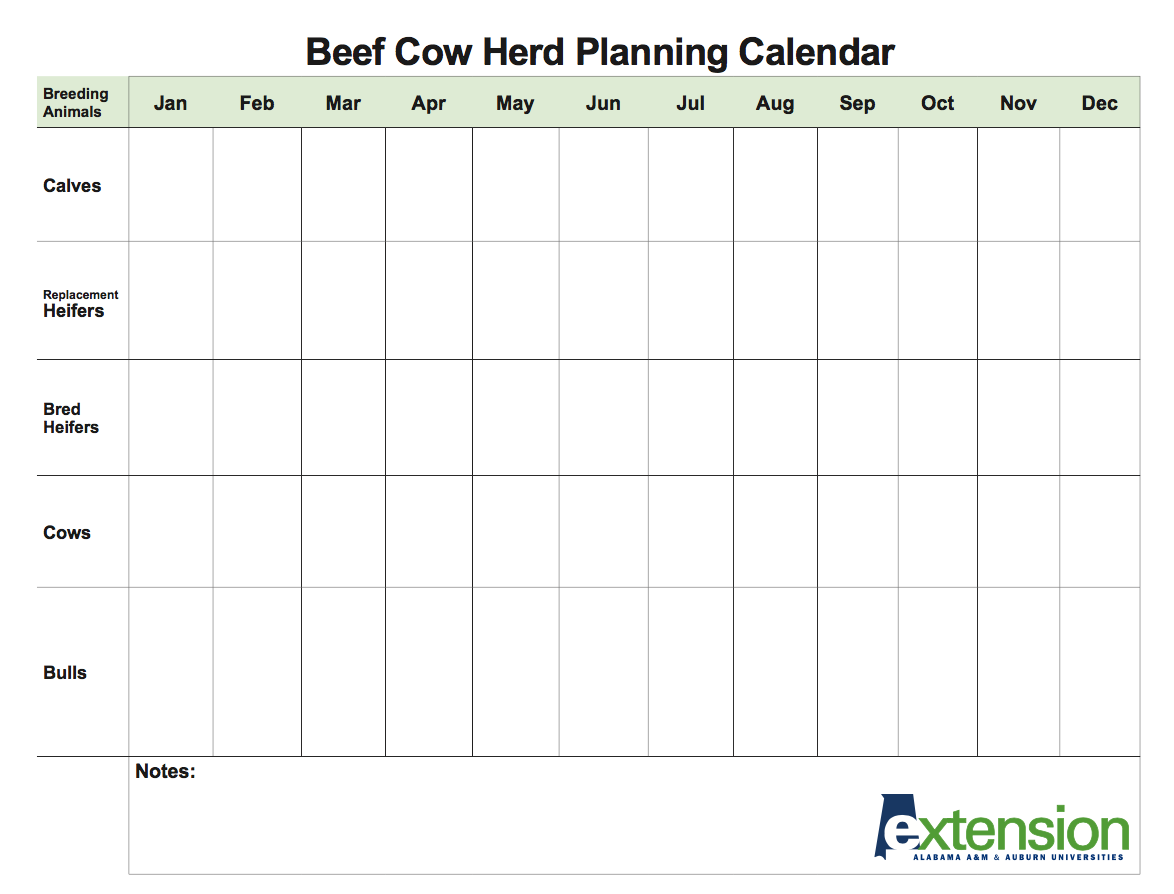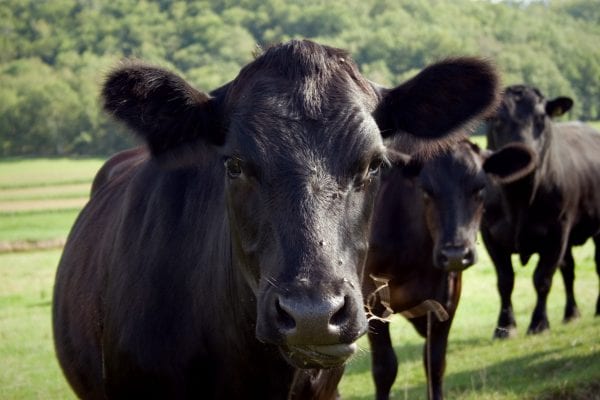Beef Cow Herd Planning Calendar: September
This is the September excerpt of Beef Cow Herd Planning Calendar, ANR-0968-A.
Health Tips
- Reduce cattle stress during hot weather; provide adequate shade and water.
- Watch for pinkeye.
Forage & Nutrition Notes
- Monitor body condition scores and adjust nutritional program as needed.
- Watch for fall armyworms in pastures and hay fields.
- Prepare to stockpile tall fescue and bermudagrass pastures for winter grazing.
- Watch dallisgrass pastures for ergot contamination.
- Plant and fertilize cool-season forages in prepared seedbeds.
Winter Calving Herd
- Wean calves based on market and pasture conditions, and deworm at weaning.
- Vaccinate for respiratory and other diseases based on veterinary advice.
- Train calves to eat from a bunk and drink from a water trough.
- Perform pregnancy checks on cows/heifers and cull on pregnancy status, soundness, health, and performance.
Spring Calving Herd
- Market bulls that will not be used again for breeding.
- Schedule pregnancy checks 45 to 60 days after the end of the breeding season.
- Observe cows and heifers for return to heat.
Fall Calving Herd
- Monitor bred heifers closely for calving.
- Maintain good calving records.
- Establish an ID system, and tag calves at birth.
- After calving, plan to move cow-calf pairs to clean pasture to minimize health risk.
Related Topics
This is the December excerpt of Beef Cow Herd Planning Calendar, ANR-0968-A.
Health Tips
- Monitor cattle for lice.
- Supplement vitamin A, when necessary, if frosted grass or weathered hay is the primary forage source.
Forage & Nutrition Notes
- Monitor body condition scores, and adjust nutritional program as needed.
- Continue using stockpiled tall fescue and bermudagrass.
- Limiting grazing cool-season annuals for a few hours per day is a good way to use winter forages efficiently once they reach a target height of 6 to 8 inches.
- Modify winter supplementation based on forage analysis information, availability, and herd nutritional requirements.
Winter Calving Herd
- Make sure calving supplies are on hand.
- Move heifers into clean, dry pastures, and check frequently.
- Monitor bred heifers closely for calving.
- Tag calves at birth, and keep good calving records (birth weight, tag numbers, cow IDs).
- Establish an ID system, and tag calves at birth.
Spring Calving Herd
- Train calves to eat from a bunk and drink from a water trough.
- Select and permanently identify replacement heifers.
- Plan a heifer development program to reach target breeding weights.
Fall Calving Herd
- Calculate fall calving percentage.
- Watch calves for scours, and restock calving supplies.
- Begin breeding replacement heifers to calve about 1 month before cows.
- Expect heifers bred by early December to calve by mid-September.
- Tag, castrate, dehorn, and implant calves as soon as practically possible. Do not implant replacement heifers.
This is the October excerpt of Beef Cow Herd Planning Calendar, ANR-0968-A.
Health Tips
- Heat stress conditions are still possible in some areas.
- Horn and face fly season is ending. Remove remaining insecticidal fly tags.
Forage & Nutrition Notes
- Monitor body condition scores and adjust nutritional program as needed.
- Consider overseeding warm-season perennial pastures with cool-season annual grasses and legumes.
- Conduct a forage analysis on stored hay, baleage, and silage before feeding to develop an accurate supplementation strategy.
Winter Calving Herd
- Finish weaning late calves.
- Train calves to eat from a bunk and drink from a water trough.
- Select and permanently identify replacement heifers.
- Plan a heifer development program to reach target breeding weights.
Spring Calving Herd
- Perform pregnancy check on cows/heifers and cull cows/ heifers based on pregnancy status, soundness, health, and performance.
- Make sure calves are weaned and weighed within acceptable age range for breed associations and performance record keeping.
- Plan a heifer development program to reach target breeding weights.
Fall Calving Herd
- Tag, castrate, dehorn, and implant calves as soon as practically possible. Do not implant replacement heifers.
- Provide good nutrition for lactating cattle and first-calf heifers approaching breeding.
- Evaluate bulls and line up breeding soundness evaluations.
This is the November excerpt of Beef Cow Herd Planning Calendar, ANR-0968-A.
Health Tips
- Watch for lice and treat as needed.
- Remove any remaining insecticidal ear tags. Old tags release low levels of insecticide that tend to promote development of resistance.
- Follow up on internal parasite control practices.
Forage & Nutrition Notes
- Monitor body condition scores, and adjust nutritional program as needed.
- Modify winter supplementation based on forage analysis information, availability, and herd nutritional requirements.
- Implement management intensive grazing systems on stockpiled tall fescue and bermudagrass.
- Begin monitoring for cool-season annual weed pressure as cool-season forages begin to grow.
- Conduct a forage analysis on stored hay, baleage, and silage before feeding to develop an accurate supplemental strategy.
Winter Calving Herd
- Check weaned calves regularly for health problems.
- Separate bred heifers from the cows, and provide adequate nutrition.
Spring Calving Herd
- Perform a pregnancy check on cows/heifers and cull cows/heifers based on pregnancy status, soundness, health, and performance.
- Implement calf preconditioning programs including vaccinations, weaning strategies, and bunk breaking.
- Select replacement heifers and permanently identify them.
- Wean calves, if not already weaned, depending on pasture conditions and marketing plans.
- Wean calves depending on pasture conditions and marketing plans. After weaning, cull cows based on pregnancy status, soundness, health, and performance.
- Deworm calves at weaning.
Fall Calving Herd
- Tag, castrate, dehorn, and implant calves as soon as practically possible. Do not implant replacement heifers.
- Provide good nutrition for lactating cattle approaching breeding.
- Make sure your bull is ready for breeding season by having a breeding soundness exam done 60 days before the breeding season.
- For artificial insemination programs, have ample semen and supplies on hand. Schedule for estrus synchronization programs, and reserve an artificial insemination technician.


